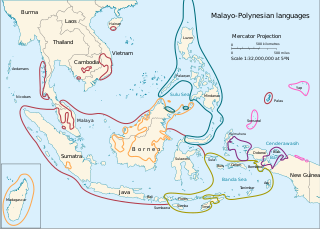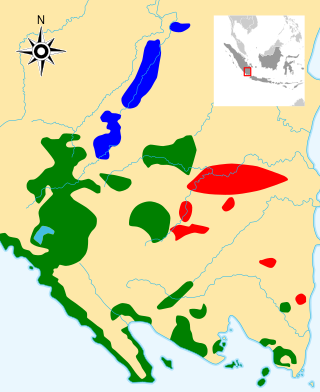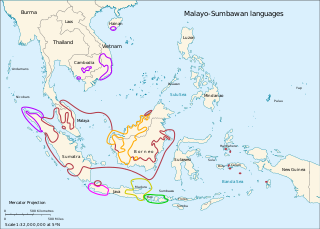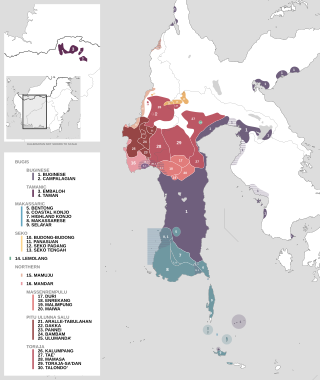Related Research Articles

The Austroasiatic languages are a large language family spoken throughout mainland Southeast Asia, South Asia and East Asia. These languages are natively spoken by the majority of the population in Vietnam and Cambodia, and by minority populations scattered throughout parts of Thailand, Laos, India, Myanmar, Malaysia, Bangladesh, Nepal, and southern China. Approximately 117 million people speak an Austroasiatic language, of which more than two-thirds are Vietnamese speakers. Of the Austroasiatic languages, only Vietnamese, Khmer, and Mon have lengthy, established presences in the historical record. Only two are presently considered to be the national languages of sovereign states: Vietnamese in Vietnam, and Khmer in Cambodia. The Mon language is a recognized indigenous language in Myanmar and Thailand, while the Wa language is a "recognized national language" in the de facto autonomous Wa State within Myanmar. Santali is one of the 22 scheduled languages of India. The remainder of the family's languages are spoken by minority groups and have no official status.

The Austronesian languages are a language family widely spoken throughout Maritime Southeast Asia, parts of Mainland Southeast Asia, Madagascar, the islands of the Pacific Ocean and Taiwan. They are spoken by about 386 million people. This makes it the fifth-largest language family by number of speakers. Major Austronesian languages include Malay, Javanese, Sundanese, Tagalog, Malagasy and Cebuano. According to some estimates, the family contains 1,257 languages, which is the second most of any language family.

The Malayo-Polynesian languages are a subgroup of the Austronesian languages, with approximately 385.5 million speakers. The Malayo-Polynesian languages are spoken by the Austronesian peoples outside of Taiwan, in the island nations of Southeast Asia and the Pacific Ocean, with a smaller number in continental Asia in the areas near the Malay Peninsula, with Cambodia, Vietnam and the Chinese island Hainan as the northwest geographic outlier. Malagasy, spoken in the island of Madagascar off the eastern coast of Africa in the Indian Ocean, is the furthest western outlier.
The Western Malayo-Polynesian (WMP) languages, also known as the Hesperonesian languages, are a paraphyletic grouping of Austronesian languages that includes those Malayo-Polynesian languages that do not belong to the Central–Eastern Malayo-Polynesian (CEMP) branch. This includes all Austronesian languages spoken in Madagascar, Mainland Southeast Asia, the Philippines, the Greater Sunda Islands, Bali, Lombok, the western half of Sumbawa, Palau and the Mariana Islands.

The Philippine languages or Philippinic are a proposed group by R. David Paul Zorc (1986) and Robert Blust that include all the languages of the Philippines and northern Sulawesi, Indonesia—except Sama–Bajaw and the Molbog language—and form a subfamily of Austronesian languages. Although the Philippines is near the center of Austronesian expansion from Formosa, there is little linguistic diversity among the approximately 150 Philippine languages, suggesting that earlier diversity has been erased by the spread of the ancestor of the modern Philippine languages.
The Chamic languages, also known as Aceh–Chamic and Acehnese–Chamic, are a group of ten languages spoken in Aceh and in parts of Cambodia, Thailand, Vietnam and Hainan, China. The Chamic languages are a subgroup of Malayo-Polynesian languages in the Austronesian family. The ancestor of this subfamily, proto-Chamic, is associated with the Sa Huỳnh culture, its speakers arriving in what is now Vietnam from Formosa.

The Malayic languages are a branch of the Malayo-Polynesian subgroup of the Austronesian language family. The most prominent member is Malay, a pluricentric language given national status in Brunei and Singapore while also the basis for national standards Malaysian in Malaysia and Indonesian in Indonesia. The Malayic branch also includes local languages spoken by ethnic Malays, further several languages spoken by various other ethnic groups of Sumatra, Indonesia and Borneo even as far as Urak Lawoi in the southwestern coast of Thailand.

Lampung or Lampungic is an Austronesian language or dialect cluster with around 1.5 million native speakers, who primarily belong to the Lampung ethnic group of southern Sumatra, Indonesia. It is divided into two or three varieties: Lampung Api, Lampung Nyo, and Komering. The latter is sometimes included in Lampung Api, sometimes treated as an entirely separate language. Komering people see themselves as ethnically separate from, but related to, Lampung people.
The Kayanic or Kayan–Murik languages are a group of Austronesian languages spoken in Borneo by the Kayan, Morek Baram, Bahau, and related peoples.
The Melanau–Kajang languages or Central Sarawak languages are a group of languages spoken in Kalimantan, Indonesia and Sarawak, Malaysia by the Kenyah, Melanau and related peoples.
The Barito languages are around twenty Austronesian languages of Indonesia (Borneo), plus Malagasy, the national language of Madagascar. They are named after the Barito River located in South Kalimantan, Indonesia.

The Malayo-Sumbawan languages are a proposed subgroup of the Austronesian languages that unites the Malayic and Chamic languages with the languages of Java and the western Lesser Sunda Islands, except for Javanese. If valid, it would be the largest demonstrated family of Malayo-Polynesian outside Oceanic. The Malayo-Sumbawan subgroup is however not universally accepted, and is rejected e.g. by Blust (2010) and Smith (2017), who supported the Greater North Borneo and Western Indonesian hypotheses. In a 2019 paper published in Oceanic Linguistics, Adelaar accepted both of these groupings, in addition to Smith's (2018) redefinition of Barito languages as forming a linkage.
The Bali–Sasak–Sumbawa languages are a group of closely related languages spoken in Indonesia in the western Lesser Sunda Islands. The three languages are Balinese on Bali, Sasak on Lombok, and Sumbawa on western Sumbawa.
The Sabahan languages are a group of Austronesian languages centered on the Bornean province of Sabah.
The North Sarawakan languages are a group of Austronesian languages spoken in the northeastern part of the province of Sarawak, Borneo, and proposed in Blust.

The South Sulawesi languages are a subgroup of the Austronesian language family. They are primarily spoken in the Indonesian provinces of South Sulawesi and West Sulawesi, with a small outlying pocket in West Kalimantan.
There have been various classification schemes for Southeast Asian languages.
The Tamanic languages are a small group of languages of Kapuas Hulu Regency, West Kalimantan:
Sarawak's population is very diverse, comprising many races and ethnic groups. Sarawak has more than 40 sub-ethnic groups, each with its own distinct language, culture and lifestyle. This makes Sarawak demography very distinct and unique compared to its Peninsular counterpart. However, it largely mirrors to other territories in Borneo - Sabah, Brunei and Kalimantan.
The Moklenic or Moken–Moklen languages consist of a pair of two closely related but distinct languages, namely Moken and Moklen. Larish (1999) establishes the two languages as forming two distinct subgroups of a larger Moken–Moklen branch. Larish (2005) suggests Moklenic as an alternative name for Moken–Moklen, the latter term which was originally used by Larish (1999).
References
- 1 2 3 Blust 2010, pp. 44, 47.
- ↑ Smith 2017a, p. 346–364.
- 1 2 Smith 2017b, p. 459–460.
- ↑ Blust 2010, p. 68.
- ↑ Blust 2013, p. 65.
- ↑ Blust 2010, p. 81.
- ↑ Adelaar 2005.
- ↑ Blust 2010, p. 45.
- ↑ Blust 2010, p. 48.
- ↑ Blust 2010, pp. 52–53.
- ↑ Smith 2017a, p. 28.
- ↑ Smith 2017a, p. 319.
- ↑ Smith 2017a, p. 49–50.
- ↑ Blench, Roger (2010). "Was there an Austroasiatic Presence in Island Southeast Asia prior to the Austronesian Expansion?". Bulletin of the Indo-Pacific Prehistory Association. 30. doi:10.7152/bippa.v30i0.10637.
- ↑ Kaufman, Daniel. 2018. Between mainland and island Southeast Asia: Evidence for a Mon-Khmer presence in Borneo. Ronald and Janette Gatty Lecture Series. Kahin Center for Advanced Research on Southeast Asia, Cornell University. (handout / slides)
Bibliography
- Adelaar, Alexander (2005). "Malayo-Sumbawan". Oceanic Linguistics. 44 (2): 357–388. JSTOR 3623345.
- Blust, Robert (2010). "The Greater North Borneo Hypothesis". Oceanic Linguistics. 49 (1): 44–118. JSTOR 40783586.
- Blust, Robert (2013). The Austronesian languages. Asia-Pacific Linguistics 8 (revised ed.). Canberra: Asia-Pacific Linguistics, Research School of Pacific and Asian Studies, The Australian National University. hdl: 1885/10191 . ISBN 9781922185075.
- Smith, Alexander D. (2017a). The Languages of Borneo: A Comprehensive Classification (PDF) (Ph.D. Dissertation). University of Hawai‘i at Mānoa.
- Smith, Alexander D. (2017b). "The Western Malayo-Polynesian Problem". Oceanic Linguistics. 56 (2): 435–490. doi:10.1353/ol.2017.0021.